Report on Decision Making in Product and Product Lifecycle
VerifiedAdded on 2023/06/10
|6
|843
|200
Report
AI Summary
This report provides an analysis of product lifecycles and decision-making processes within the context of marketing. It begins by defining a product and its importance in satisfying consumer needs, then explores the product levels: core, actual, and augmented. The report uses Coca-Cola as a case study to illustrate these concepts. It also discusses the product lifecycle stages, marketing mix (product, price, place, and promotion), and their significance in achieving marketing objectives. The report references several academic sources to support its claims, offering a comprehensive overview of product management and marketing strategies.
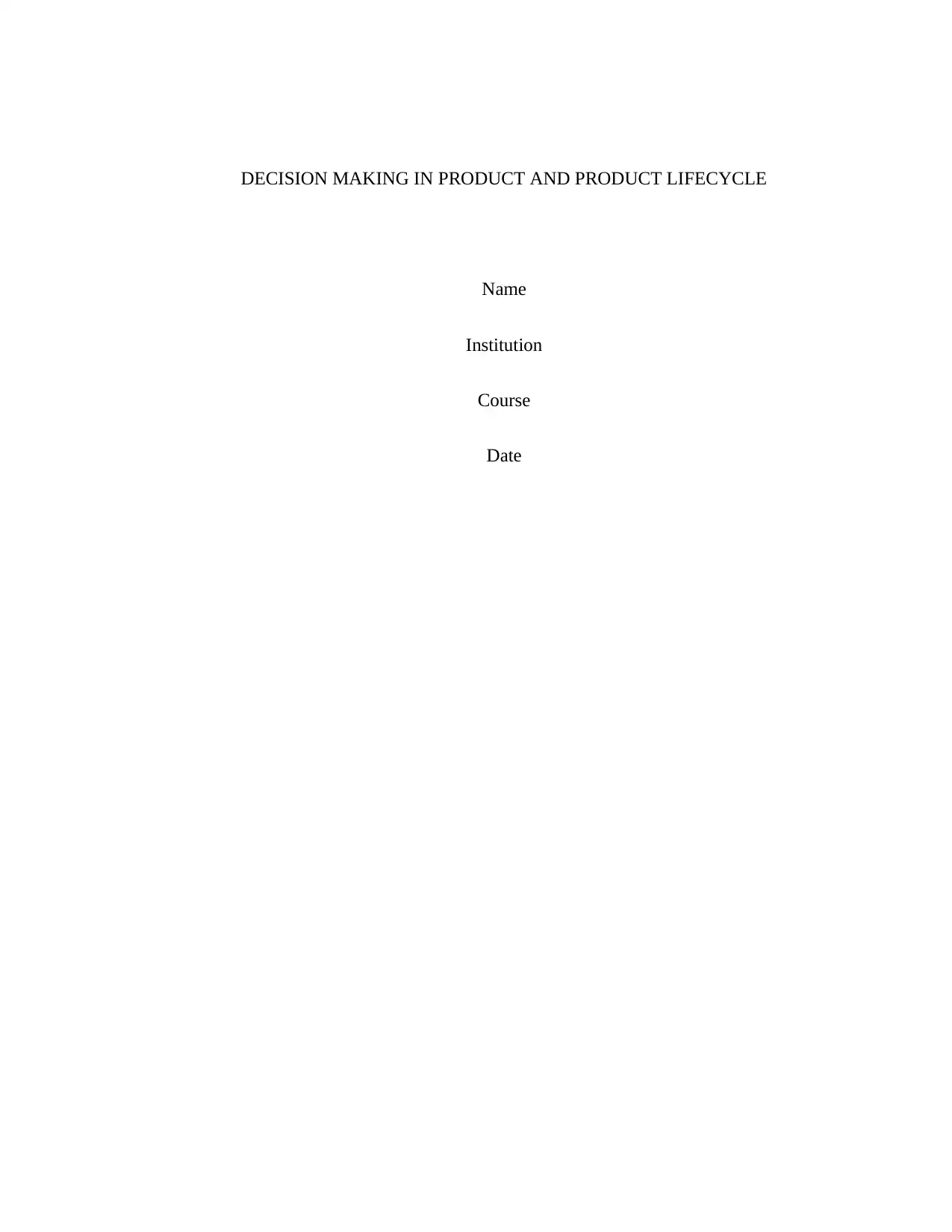
DECISION MAKING IN PRODUCT AND PRODUCT LIFECYCLE
Name
Institution
Course
Date
Name
Institution
Course
Date
Paraphrase This Document
Need a fresh take? Get an instant paraphrase of this document with our AI Paraphraser
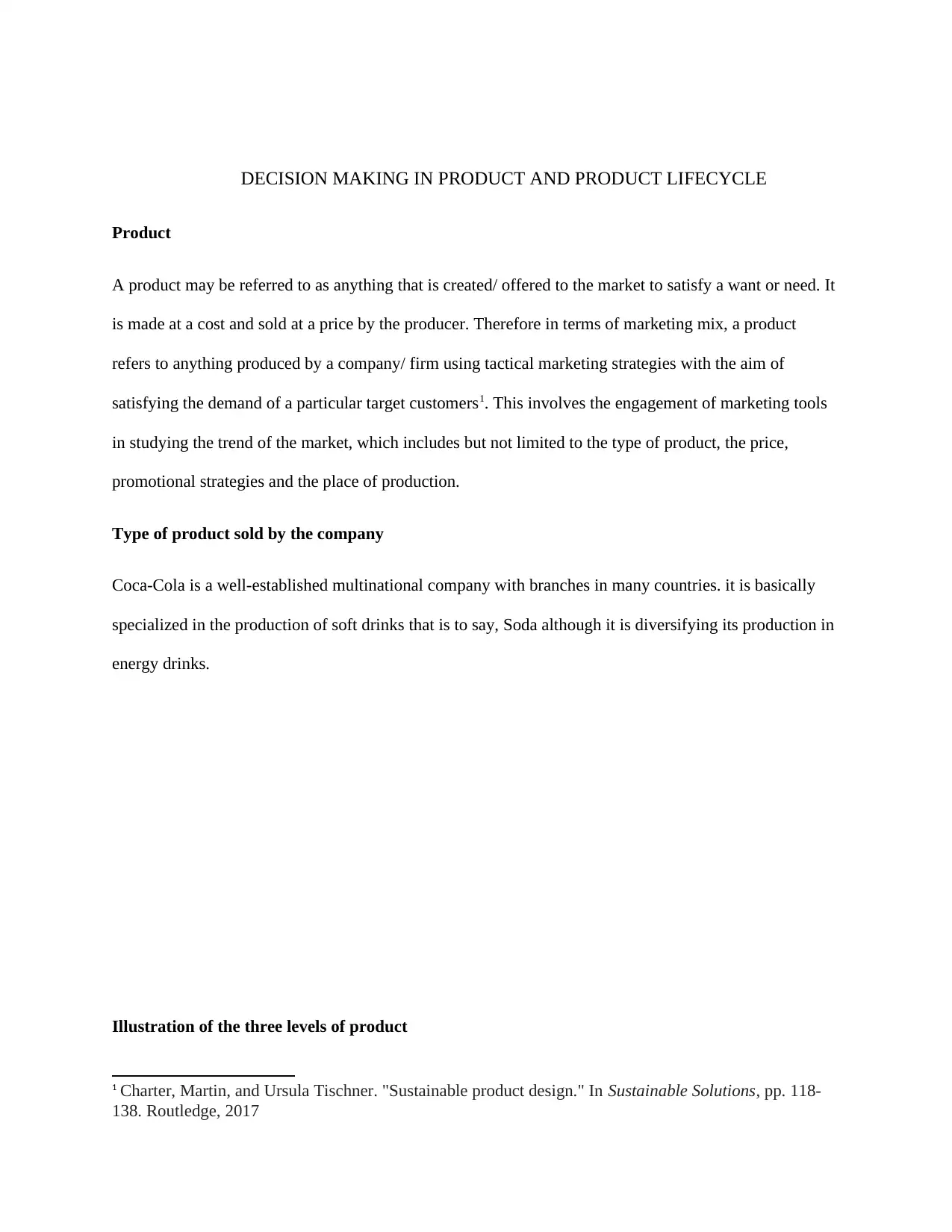
DECISION MAKING IN PRODUCT AND PRODUCT LIFECYCLE
Product
A product may be referred to as anything that is created/ offered to the market to satisfy a want or need. It
is made at a cost and sold at a price by the producer. Therefore in terms of marketing mix, a product
refers to anything produced by a company/ firm using tactical marketing strategies with the aim of
satisfying the demand of a particular target customers1. This involves the engagement of marketing tools
in studying the trend of the market, which includes but not limited to the type of product, the price,
promotional strategies and the place of production.
Type of product sold by the company
Coca-Cola is a well-established multinational company with branches in many countries. it is basically
specialized in the production of soft drinks that is to say, Soda although it is diversifying its production in
energy drinks.
Illustration of the three levels of product
1 Charter, Martin, and Ursula Tischner. "Sustainable product design." In Sustainable Solutions, pp. 118-
138. Routledge, 2017
Product
A product may be referred to as anything that is created/ offered to the market to satisfy a want or need. It
is made at a cost and sold at a price by the producer. Therefore in terms of marketing mix, a product
refers to anything produced by a company/ firm using tactical marketing strategies with the aim of
satisfying the demand of a particular target customers1. This involves the engagement of marketing tools
in studying the trend of the market, which includes but not limited to the type of product, the price,
promotional strategies and the place of production.
Type of product sold by the company
Coca-Cola is a well-established multinational company with branches in many countries. it is basically
specialized in the production of soft drinks that is to say, Soda although it is diversifying its production in
energy drinks.
Illustration of the three levels of product
1 Charter, Martin, and Ursula Tischner. "Sustainable product design." In Sustainable Solutions, pp. 118-
138. Routledge, 2017
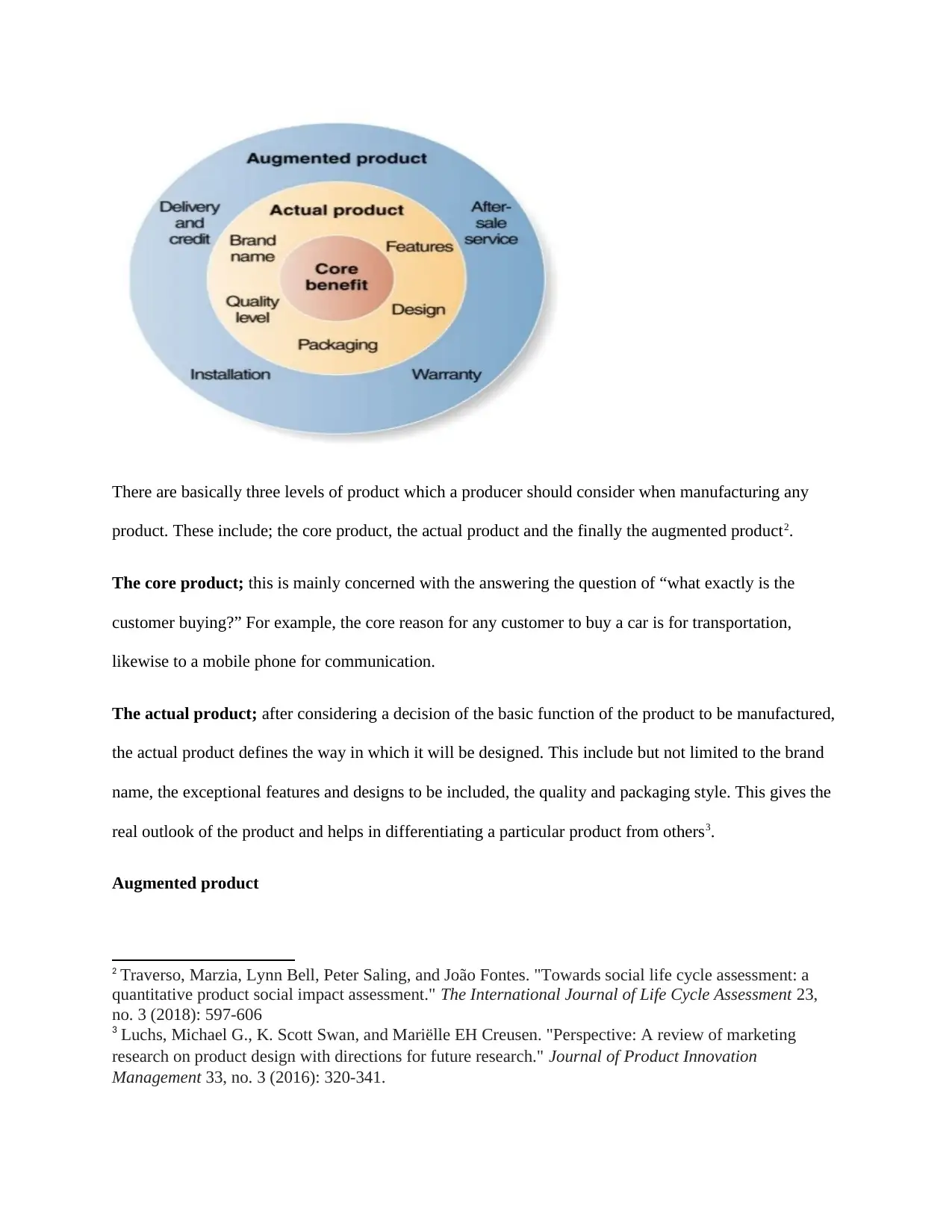
There are basically three levels of product which a producer should consider when manufacturing any
product. These include; the core product, the actual product and the finally the augmented product2.
The core product; this is mainly concerned with the answering the question of “what exactly is the
customer buying?” For example, the core reason for any customer to buy a car is for transportation,
likewise to a mobile phone for communication.
The actual product; after considering a decision of the basic function of the product to be manufactured,
the actual product defines the way in which it will be designed. This include but not limited to the brand
name, the exceptional features and designs to be included, the quality and packaging style. This gives the
real outlook of the product and helps in differentiating a particular product from others3.
Augmented product
2 Traverso, Marzia, Lynn Bell, Peter Saling, and João Fontes. "Towards social life cycle assessment: a
quantitative product social impact assessment." The International Journal of Life Cycle Assessment 23,
no. 3 (2018): 597-606
3 Luchs, Michael G., K. Scott Swan, and Mariëlle EH Creusen. "Perspective: A review of marketing
research on product design with directions for future research." Journal of Product Innovation
Management 33, no. 3 (2016): 320-341.
product. These include; the core product, the actual product and the finally the augmented product2.
The core product; this is mainly concerned with the answering the question of “what exactly is the
customer buying?” For example, the core reason for any customer to buy a car is for transportation,
likewise to a mobile phone for communication.
The actual product; after considering a decision of the basic function of the product to be manufactured,
the actual product defines the way in which it will be designed. This include but not limited to the brand
name, the exceptional features and designs to be included, the quality and packaging style. This gives the
real outlook of the product and helps in differentiating a particular product from others3.
Augmented product
2 Traverso, Marzia, Lynn Bell, Peter Saling, and João Fontes. "Towards social life cycle assessment: a
quantitative product social impact assessment." The International Journal of Life Cycle Assessment 23,
no. 3 (2018): 597-606
3 Luchs, Michael G., K. Scott Swan, and Mariëlle EH Creusen. "Perspective: A review of marketing
research on product design with directions for future research." Journal of Product Innovation
Management 33, no. 3 (2016): 320-341.
⊘ This is a preview!⊘
Do you want full access?
Subscribe today to unlock all pages.

Trusted by 1+ million students worldwide
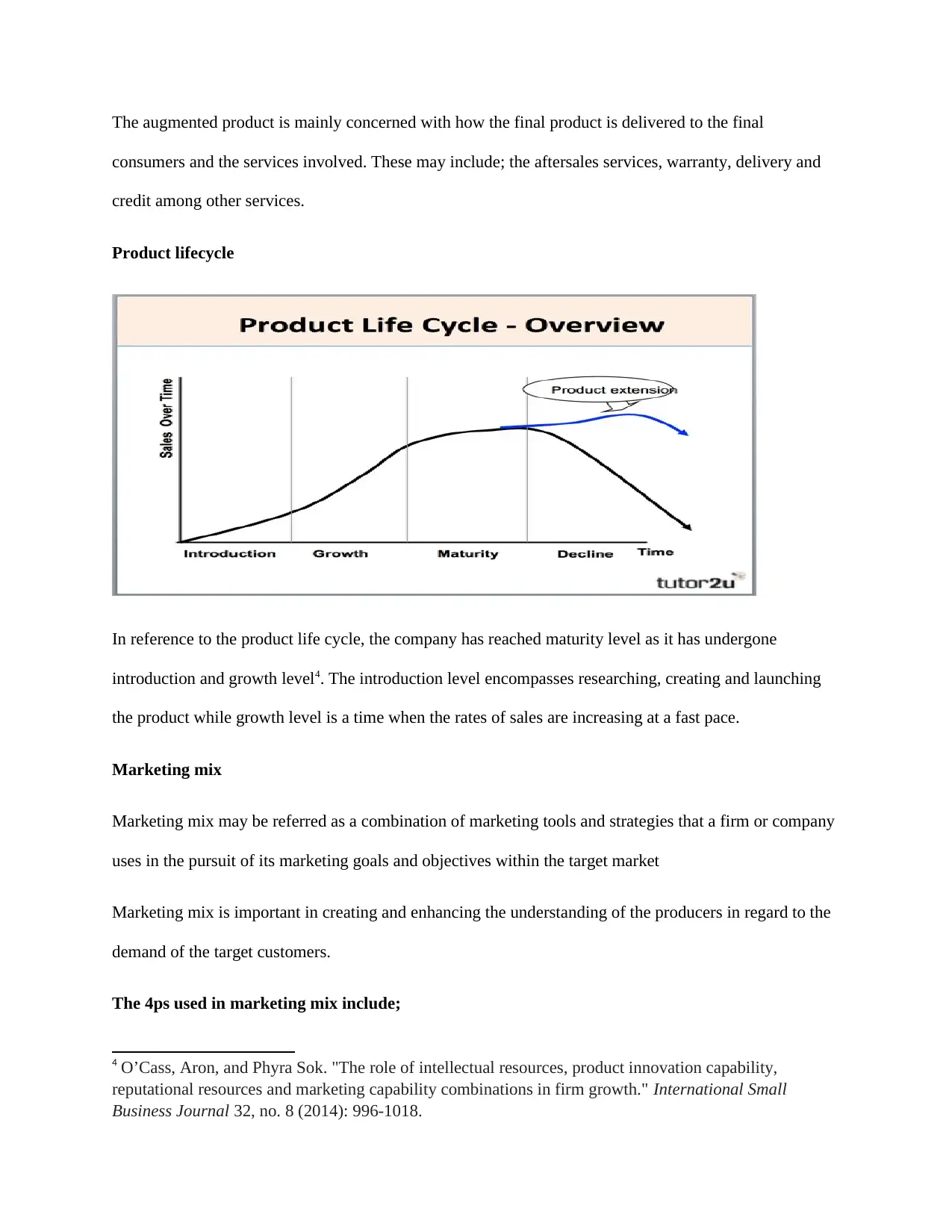
The augmented product is mainly concerned with how the final product is delivered to the final
consumers and the services involved. These may include; the aftersales services, warranty, delivery and
credit among other services.
Product lifecycle
In reference to the product life cycle, the company has reached maturity level as it has undergone
introduction and growth level4. The introduction level encompasses researching, creating and launching
the product while growth level is a time when the rates of sales are increasing at a fast pace.
Marketing mix
Marketing mix may be referred as a combination of marketing tools and strategies that a firm or company
uses in the pursuit of its marketing goals and objectives within the target market
Marketing mix is important in creating and enhancing the understanding of the producers in regard to the
demand of the target customers.
The 4ps used in marketing mix include;
4 O’Cass, Aron, and Phyra Sok. "The role of intellectual resources, product innovation capability,
reputational resources and marketing capability combinations in firm growth." International Small
Business Journal 32, no. 8 (2014): 996-1018.
consumers and the services involved. These may include; the aftersales services, warranty, delivery and
credit among other services.
Product lifecycle
In reference to the product life cycle, the company has reached maturity level as it has undergone
introduction and growth level4. The introduction level encompasses researching, creating and launching
the product while growth level is a time when the rates of sales are increasing at a fast pace.
Marketing mix
Marketing mix may be referred as a combination of marketing tools and strategies that a firm or company
uses in the pursuit of its marketing goals and objectives within the target market
Marketing mix is important in creating and enhancing the understanding of the producers in regard to the
demand of the target customers.
The 4ps used in marketing mix include;
4 O’Cass, Aron, and Phyra Sok. "The role of intellectual resources, product innovation capability,
reputational resources and marketing capability combinations in firm growth." International Small
Business Journal 32, no. 8 (2014): 996-1018.
Paraphrase This Document
Need a fresh take? Get an instant paraphrase of this document with our AI Paraphraser
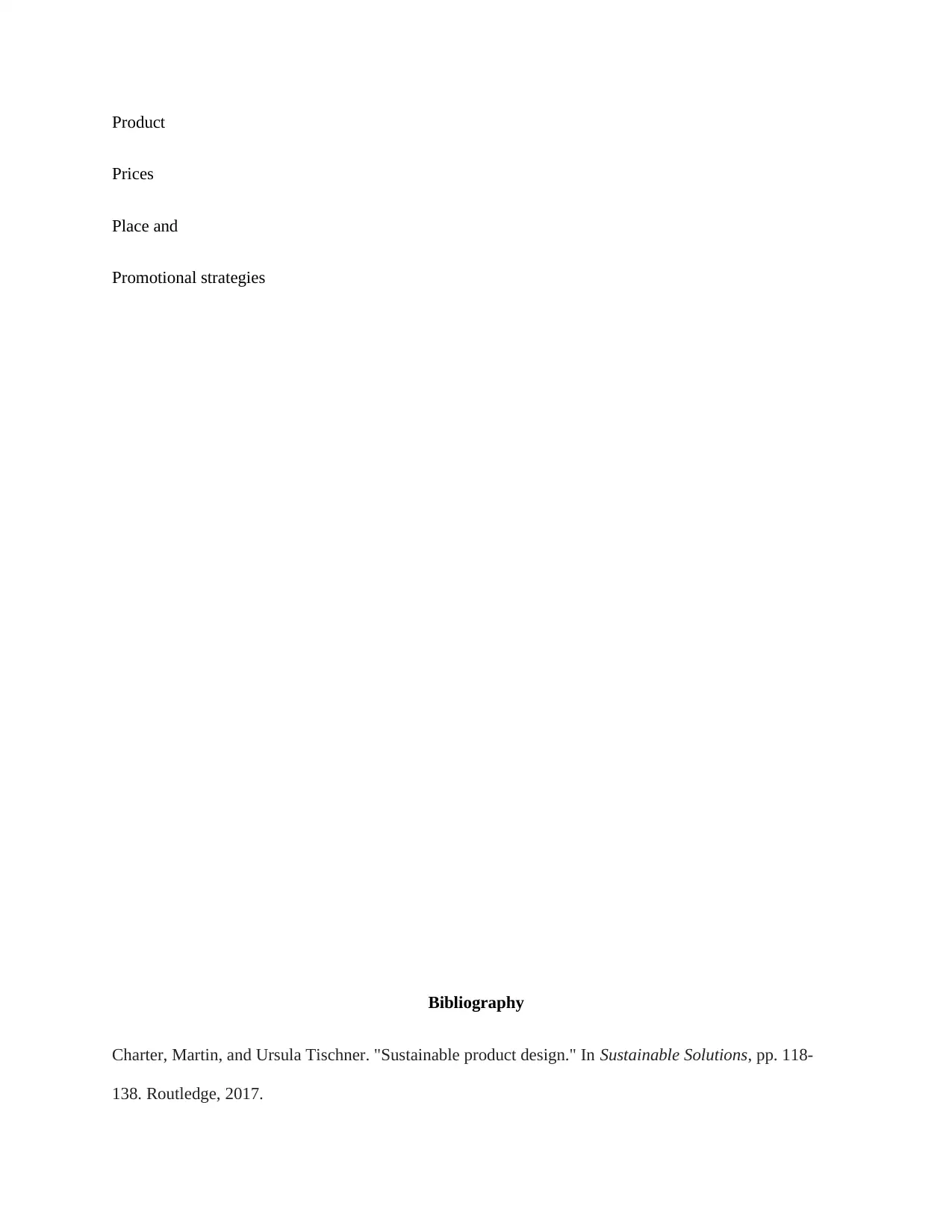
Product
Prices
Place and
Promotional strategies
Bibliography
Charter, Martin, and Ursula Tischner. "Sustainable product design." In Sustainable Solutions, pp. 118-
138. Routledge, 2017.
Prices
Place and
Promotional strategies
Bibliography
Charter, Martin, and Ursula Tischner. "Sustainable product design." In Sustainable Solutions, pp. 118-
138. Routledge, 2017.
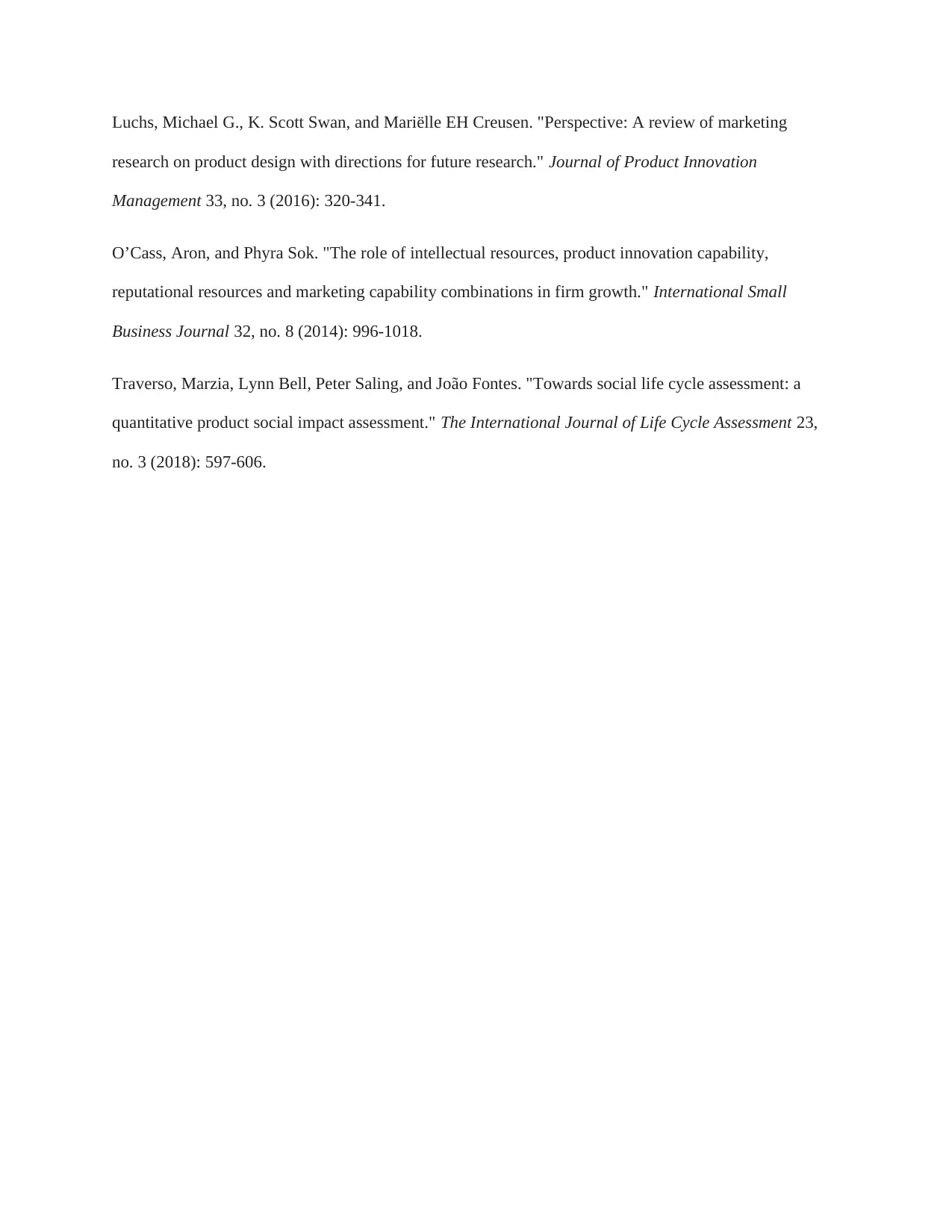
Luchs, Michael G., K. Scott Swan, and Mariëlle EH Creusen. "Perspective: A review of marketing
research on product design with directions for future research." Journal of Product Innovation
Management 33, no. 3 (2016): 320-341.
O’Cass, Aron, and Phyra Sok. "The role of intellectual resources, product innovation capability,
reputational resources and marketing capability combinations in firm growth." International Small
Business Journal 32, no. 8 (2014): 996-1018.
Traverso, Marzia, Lynn Bell, Peter Saling, and João Fontes. "Towards social life cycle assessment: a
quantitative product social impact assessment." The International Journal of Life Cycle Assessment 23,
no. 3 (2018): 597-606.
research on product design with directions for future research." Journal of Product Innovation
Management 33, no. 3 (2016): 320-341.
O’Cass, Aron, and Phyra Sok. "The role of intellectual resources, product innovation capability,
reputational resources and marketing capability combinations in firm growth." International Small
Business Journal 32, no. 8 (2014): 996-1018.
Traverso, Marzia, Lynn Bell, Peter Saling, and João Fontes. "Towards social life cycle assessment: a
quantitative product social impact assessment." The International Journal of Life Cycle Assessment 23,
no. 3 (2018): 597-606.
⊘ This is a preview!⊘
Do you want full access?
Subscribe today to unlock all pages.

Trusted by 1+ million students worldwide
1 out of 6
Related Documents
Your All-in-One AI-Powered Toolkit for Academic Success.
+13062052269
info@desklib.com
Available 24*7 on WhatsApp / Email
![[object Object]](/_next/static/media/star-bottom.7253800d.svg)
Unlock your academic potential
Copyright © 2020–2025 A2Z Services. All Rights Reserved. Developed and managed by ZUCOL.





